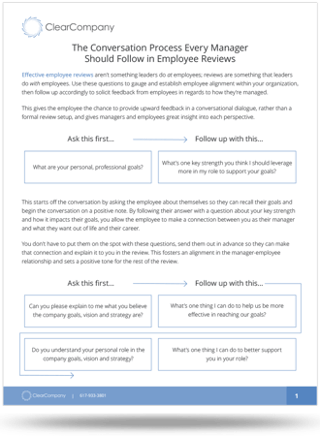The following article was posted in September of 2014. It has since been updated as of February 2017 to reflect new stats and insights involving employee retention and turnover. Want more information? We have plenty to offer in these related articles:
- 7 Ways to Improve Employee Development Programs
- A Look Back at Effecting Employee Engagement with Goals
- 5 Management Mistakes Hindering Employee Performance
In the ClearCompany blog we talk often about retention efforts like employee feedback, 360-performance management and effective communication tools and practices. We spend a lot of time on the topic of retention because we know our audience, and it happens that about 52% of you have likely prioritized attraction and retention as a major business issue.
In light of this growing and common business issue, we compiled several statistics that are meant to really drive home the importance of a great retention strategy. How is yours looking?
1. 40% of employees who left their jobs voluntarily in 2013 did so within six months of starting in the position. (Click to Tweet)
2017 Stat: 42% of millennials expect to change jobs at least every 1-3 years.
Proper onboarding has been an overlooked part of the hiring process for long enough. We consistently see an obvious correlation between strong onboarding processes, and higher retention rates. It might be time to revisit your onboarding process, collect feedback and refresh.
2. The average cost to replace an $8/hour employee is about $5,500, not including benefits. (Click to Tweet)
2017 Stat: $11 billion is lost annually due to employee turnover.
Sometimes losing an employee is completely necessary, but all too often it is easily avoided. Managers need to think more strategically about turnover costs. If it will cost the organization much more to lose and replace an employee than to incentivize their retention in some way, it is an obvious choice to work at keeping that employee.
3. The average direct cost for a new employee (not including training) is $57,968. (Click to Tweet)
2017 Stat: Cost of replacing entry level employees: 30-50% of their annual salary.
Human capital is almost always the most costly investment for an organization, but it is very often mismanaged. Using tools that improve communication, performance and career planning can improve retention, mitigating the cost of new hires.

4. Of the nearly 1,000 companies surveyed, only 9% of senior management believes that turnover is an urgent issue. (Click to Tweet)
That number is pretty pathetic, especially when you consider that the high cost of turnover isn’t really news to anyone. A focus on retention efforts has to become part of the company culture. Many organizations in high turnover industries seem to give into the fact that they will always face this issue. That doesn’t have to be the case, and it is an extremely costly compromise to make.
5. More than 50% of voluntary turnover happens within a year of the new hires' start dates. (Click to Tweet)
2017 Stat: 50% of employees say that are planning to stay at their current company for two years or less.
Although there is some truth to the adage, “People quit bosses, not jobs”, there is almost always more to it. Organizations need to offer solid onboarding, superior training, solicit feedback from workers and (here’s the kicker) actually use that feedback. Employees need regular recognition, access to career planning tools and fulfillment at work. Retention isn’t some code that we haven’t cracked yet; we all know what needs to be done to decrease this high cost business risk –now for the action.
6. More than 64% of new hires in retail and about 66% of those in leisure will leave within the first year. (Click to Tweet)
It’s a harsh reality that some industries have to put more into their retention initiatives than others. If you are in a high turnover industry, retention needs to be made a priority in the day-to-day strategy of leadership. When we’re looking at numbers like that, retention efforts do need daily attention.
7. Voluntary turnover in general was up 3.5% in 2013. (Click to Tweet)
2017 Stat: 69% of hiring managers say voluntary turnover has not increased at their companies in 2016.
So in other words, the problem isn’t going away; it’s really only getting worse.
“Staff-turnover costs go way beyond recruiting and training costs. When employees leave, so does quite a bit of valuable knowledge. Stemming the tide and making sure you keep knowledge in-house requires both a strategy and some technology.” - Bob Weinstein, TechRepublic
I couldn’t have said it better myself, Weinstein. When strategy meets the tech tools to make a vision a reality, it can be a beautiful thing. Especially as organizations grow and become more dynamic, the right technology is essential in helping managers track performance so they can address issues and celebrate successes in real-time, implement effective 360-performance reviews and help employees create professional goals that align with those of the organization.
Want to know more about how Clear Company can help you mitigate the costs associated with turnover? Learn more now.
.png)


